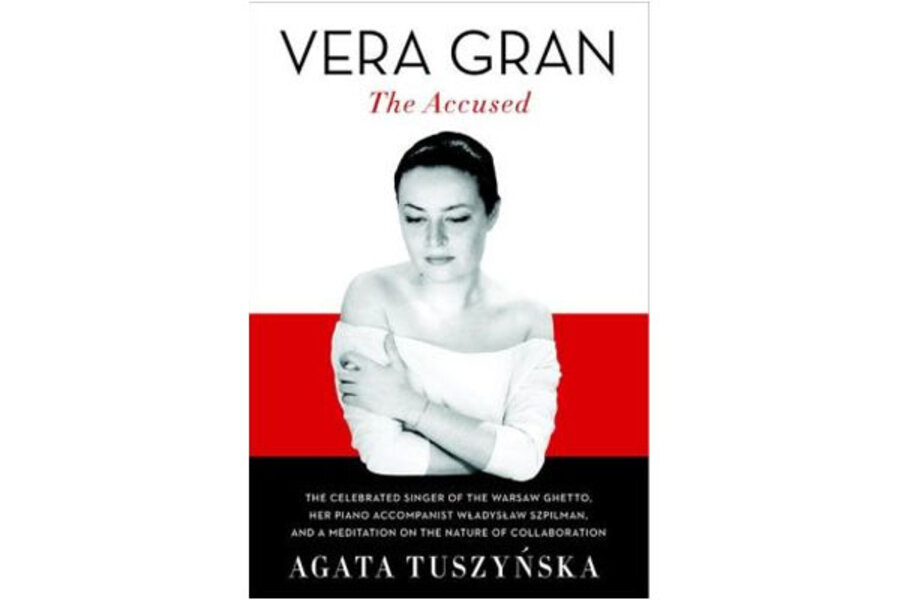Vera Gran: The Accused
Loading...
The story of Vera Gran – the beautiful 1930s Polish singing star who was caught for a year in the Warsaw Ghetto during World War II and later dogged by suspicions that she had collaborated with the Nazis – ought to be many things.
A reader might reasonably expect a touch of prewar glamor and a large measure of the horror and suspense that marked Roman Polanski's Oscar-winning 2002 film "The Pianist." That movie, after all, told the story of Wldayslaw Szpilman, who was Gran's accompanist, ultimately trapped in the same ghetto.
Instead, Vera Gran: The Accused, Agata Truszynska’s archeological dig of Gran, is less history than obsession. It’s as much about Tuszynska as it is about Gran, and in the end, neither is compelling enough for such a labored work.
Tuszynaska knew Gran toward the end of her life, when she was living in a basement apartment in Paris. Tuszynska frames her book as a biography of Gran, who died in 2007. But Tuszynaska detours incessantly, bringing up figures without demonstrating their importance to the narrative, and interrupting what could have been a more direct, dramatic account with musings on her reportorial process.
Today Gran's story is significant largely because of her relationship to Szpilman, a far more famous ghetto icon. But while Szpilman would go on to become a symbol of courage for his survival and resistance, Gran instead was a pariah in Israel for her alleged collaboration with the Nazis. She, in turn, accused Szpilman of being a Gestapo policeman who sent Jews to their death.
Szpilman, who didn’t mention Gran in his autobiography (she also doesn’t figure in the film, at least not by name), denied the charge.
The larger story here is a tale of revenge, vindication, and the shades of grey that segmented ghetto society and color history. In telling that story Truszynska occasionally offers a sharp insight and her treatment of Gran in old age – losing her senses and, saddest of all, her style – is sensitive.
But too often reading this book feels like a chore.
To Truszynska's credit, she doesn’t miss a detail; but at the same time, she doesn’t explain them. For instance, do non-Polish readers really know what a "coffer" is? Yet Tuszynska writes of a visit to Gran’s apartment: “A wooden box fell down from a shelf. A small coffer, like those souvenirs from the Polish mountains. The contents scattered on the floor in the dust among old newspapers.”
This fitful chronicle of a World War II torch singer certainly attests to the author’s drive; not only did she spend years retracing Gran’s journeys, she also pored over contemporary documents and tracked down many ghetto survivors, contextualizing Gran’s life so richly that, unfortunately, this portrait numbs more than it illuminates.
Tuszynska’s evocation of life in the ghetto in the early ‘40s may be more interesting than Gran’s story. She effectively details how claustrophobia, paranoia, and persecution came to supplant the commerce and neighborliness that once characterized the area. She also turns up evidence of how Gran was persecuted from country to country; Israel was particularly judgmental and slow to view her in a more favorable and forgiving light.
The book doesn’t paint Gran in a particularly kindly light either. She comes off as immune to self-doubt and convinced of her uniqueness and beauty, rather like Norma Desmond in “Sunset Boulevard.” Gran was indeed striking and, by all accounts, a singular singer, a Polish Edith Piaf. But she too often remains opaque, despite Tuszynska’s doggedness.
There are moments, however, when Gran comes into focus. Here, for instance, as Gran nears her death, writer and subject blend perfectly:
“She is in her pink dressing gown closed with safety pins. I’m in black. She comes up to my chest. She holds on to me with a clenched hand so as not to fall, but at the same time she attempts to lead, to set the tempo. She tries. She rolls her eyes coquettishly, she wants to be seductive, and she weeps because she bears half a century on her shoulders and walking is difficult, like finding the rhythm and not getting dizzy. She mumbles each step of the dance. A smile, wide, joy, she is dancing, we dance.”
Carlo Wolff is a Monitor contributor








